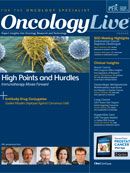Five Questions for Hans-Peter Gerber, PhD
Hans-Peter Gerber has been building a program to develop novel biotherapeutics for oncology, including antibody-drug conjugates, at the Pfizer Oncology Research Unit in Pearl River, New York.
Hans-Peter Gerber, PhD
Vascular Biology/BioConjugate Group Pfizer Oncology Research Unit Pearl River, NY
Hans-Peter Gerber has been leading the Vascular Biology/BioConjugate group at the Pfizer Oncology Research Unit in Pearl River, New York, since the acquisition of Wyeth in late 2009, building a program to develop novel biotherapeutics for oncology, including antibody-drug conjugates (ADCs). He has previously served as head of the Translational Biology Department at Seattle Genetics, where he contributed to the development of therapeutic antibodies and ADCs, including brentuximab vedotin (Adcetris, formerly called SGN-35) and SGN-75, and as a visiting scientist at Genentech, where he spent 11 years developing therapeutic antibodies that interfere with tumor angiogenesis. He is the author of more than 80 scientific publications and 10 book chapters, and co-inventor on 15 issued patents.
1
What are ADCs?
The basic concept for ADCs is to combine the strengths of the two most successful classes of therapeutic compounds developed in oncology–the high selectivity of antibodies with the unrivaled potency of cytotoxic drugs–with the goal to increase the therapeutic index.
2
What is their therapeutic role in cancer?
Conventional monoclonal antibody therapeutics interfere with signaling functions of their target antigens but are frequently limited in their ability to induce significant antitumor responses when administered as single agents in patients with solid tumors. In support of this notion, most, if not all, current biologic compounds approved for the treatment of solid tumors are combined with standard-of-care treatment, which often include cytotoxic compounds. To overcome these limitations, several new technologies, including ADCs, are being developed to empower biotherapeutics and to improve their antitumor activities as single agents while maintaining their high tumor selectivity and good safety profiles.
3
What ADCs are currently available?
Currently, there is one approved ADC available, known as SGN-35 [brentuximab vedotin/Adcetris], an anti-CD30-auristatin conjugate that achieved >70% objective response rates in refractory Hodgkin lymphoma (HL) patients and >80% in anaplastic large cell lymphoma (ALCL) patients.
Approximately 60 ADCs are being developed in oncology and more than 25 are undergoing clinical testing. The most common drugs or payloads used for conjugation to the targeting vehicles include tubulin inhibitors (such as auristatins, maytansines) or DNA double strand break-inducing compounds (such as calicheamicin) and DNA minor groove binder/ alkylators (such as duocarmycins). The majority of these payloads are derived from natural products. Among the more than 15 ADC programs undergoing clinical testing in solid tumors, 14 are based on tubulin inhibitors, including auristatins and maytansinoids, and one program incorporates a DNA minor groove binder/alkylator (duocarmycin).
Auristatins are highly potent tubulin inhibitors, which interfere with tubulin polymerization and induce rapid cell death at low intracellular concentrations. Several auristatin-based drug conjugates are currently being developed as ADC payloads in preclinical and early-stage clinical studies. About half of the clinical programs use auristatin-based conjugates, consisting of a fully synthetic, pentapeptide tubulin inhibitor, which induces G2/M cell cycle arrest, leading to cell death.
An anti-CD22 calicheamicin conjugate (CMC-544) is currently being tested in non-Hodgkin lymphoma (NHL) and acute lymphoblastic leukemia (ALL) patients in combination with rituximab, and objective response rates of >80% have been reported in refractory NHL patients.
4
What is the most significant discovery related to ADCs in recent years?
The key challenges in ADC research include improvements in potency and safety. The field is making rapid progress toward a better understanding of the physicochemical properties of ADCs, the biology of their targets, and how they impact the therapeutic index. Recent improvements in drug linker conjugations, in particular site-specific conjugation methods, resulted in a significant reduction in the off-target toxicity and potentially increased the therapeutic indexes of ADCs.
5
What is the future of ADC research?
The development of novel research concepts to study ADC targets, along with targeting vehicles, linkers, and payloads, have transformational potential for ADC development. One of the most promising areas of future ADC research is the identification of novel targets with optimal internalization kinetics and intracellular trafficking properties. The development of technologies enabling the screening of a large repertoire of targeting vehicles to select for compounds with optimal characteristics may represent an important future trend in ADC development.




